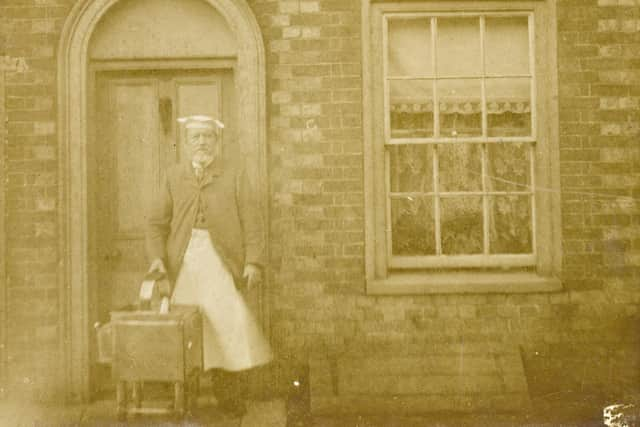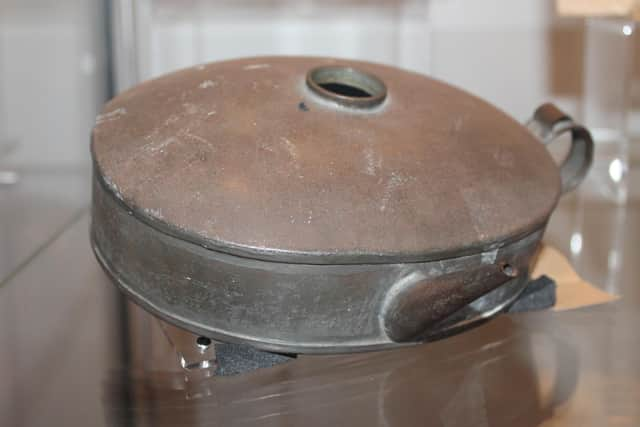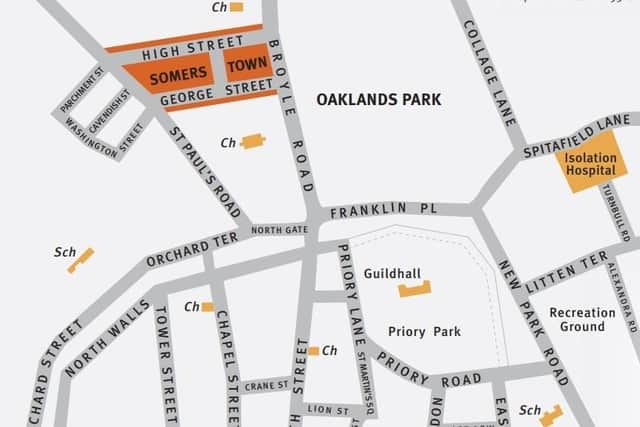Somerstown, Chichester and Old Joe the pie man – who gets a mention in Kate Mosse's book The Taxidermist’s Daughter
and live on Freeview channel 276
To meet demand for rented accommodation near the city centre, the building of Somerstown began in the early 19th century. The building of the High Street began in 1812, shortly followed by Cross Street and George Street. Parchment Street, Washington Street, Cavendish Street and Orchard Street were subsequently built between 1847 and 1851.
Joe Faro, a Somerstown resident who lived in George Street, was a popular baker and was long remembered for his pies during the Victorian era. ‘Old Joe’, as he was known, was a regular sight in and around Chichester between the years 1863 to 1913.
Advertisement
Hide AdAdvertisement
Hide AdJoe specialised in selling hot pies that had been cooked in his portable oven, as well as other items such as biscuits and sweets. Joe constructed the oven from tin, and charcoal was placed in a basket on the floor of the oven. Gravy for the pies was made in a separate oval container, which was kept warm by being placed on top of the oven.


His principle selling site was at the Market Cross in the centre of Chichester. Additionally, Joe would meet the morning trains coming into the city and every Wednesday, at midday, he would sell his goods at the Cattle Market. Joe was also a regular trader at the city's Sloe Fair, which took place, and still does, annually in October.
Once developed, Somerstown remained largely unchanged until after the Second World War. There was a strong sense of community among the residents, especially since many generations of the same family had grown up alongside each other in the neighbourhood.
It supported a host of shops and businesses, including grocery stores, sweet shops, bakeries, a snack bar, an antique shop, a scrap yard and even nine pubs! A number of these pubs were situated in Broyle Road, including the Bell Inn, Beehive, Freetraders Hall and Spotted Cow.
Advertisement
Hide AdAdvertisement
Hide AdThe Bell Inn is a low-level Regency-style building which has seen a number of landlords, including former drayman Rob Thomas with his wife Jan. Thomas was the landlord from 1982 to 1992. In 1992, The Bell Inn was shortlisted for a Whitbread Pub Cask Ale Standards award. There were 500 entries for this award, and they were in the top 25!


The Rainbow pub, formally The Happy Medium, similarly had multiple landlords, notably Nick May in 1995. To celebrate the 50th anniversary of D-Day, May promised to charge 1945 prices for beer that day, provided all customers paid in old money – 7d a pint. That year they also won the Chichester Observer’s Pub of the Month.
Summer outings were arranged to the seaside, sometimes in charabancs and coaches hired specially. In 1945, VE day was celebrated with a street party in the High Street.
By the 1950s, the houses in Somerstown, many of which had only two bedrooms, no heating or bathrooms and an outside toilet, failed to meet modern housing standards, especially when compared with the state-of-the-art new council houses springing up around the country. Some houses had fallen into disrepair because the owners were not able to pay for redecoration, or necessary repair work.
Advertisement
Hide AdAdvertisement
Hide AdIn 1955, acting on government recommendations, the city council announced a five-year programme of ‘slum clearance’ and redevelopment. A total of 426 houses were earmarked for demolition, including many in Somerstown. The council’s plans for Somerstown did not stop there. To fully redevelop the area, it was decided that all houses within Somerstown should be demolished despite their condition.


Some residents were happy to give up their accommodation, while others were determined not to lose their homes. Despite this, in 1958, the council applied for a compulsory purchase order from the government to acquire the properties and clear residents from the area. A programme of demolition began in March 1960.
The council had an ambitious vision for redevelopment, commissioning the renowned architect Sir Hugh Casson to design a scheme of homes and shop units. However, this scheme fell through and the plot was instead sold to Downland Housing Association, under the condition they construct 151 dwelling units within three years.
All that now remains of Somerstown are two pubs, The Bell Inn and its adjoining cottages, in Broyle Road and The Rainbow, in St Pauls Road.
Advertisement
Hide AdAdvertisement
Hide AdJoe Faro died in 1913 but his legacy continued and he has since been mentioned in several books by local authors. Notably, in 1928, TG Willis recorded that 'there were two well-known and welcome visitors who came into the town every morning carrying their highly polished ovens […] The well-known cry of "Pies Hot!" was eagerly looked forward to and welcomed’.
More recently, local author Kate Mosse referred to ‘a flower seller and Joe Faro, nursing his pie oven sheltered under the Market Cross’ in her book The Taxidermist’s Daughter.
You can view Joe’s pie oven, gravy pot, bakers’ hat and the very paper bags that Joe used to pack his baked goods, on display on the first floor at The Novium Museum. Visitors are also encouraged to read about the history of Somerstown in the foyer gallery space, also on the first floor.